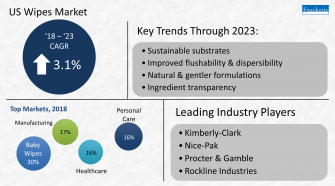End-Use Markets

Demand for wipes in healthcare settings to increase 3.8% annually
Demand for wipes used in healthcare settings is expected to increase 3.8% per year to $594 million in 2023, according to a new report. Gains will be driven by robust …

Heimtextil 2019: New fiber functionality for a mass market
Attracting over 3,000 exhibitors to Frankfurt in Germany, the 49th Heimtextil home textiles show kicked off the 2019 textile trade fair calendar from January 8-11th.The European home textiles market is worth around an annual €27 billion and serviced by a decidedly global supply chain, reflected in the event’s participants hailing from no less than 65 countries.Among them were some of the leaders in fibers and raw materials, such as Germany’s Trevira, which leads the field with its Trevira

Denim manufacturers are eager for fiber innovations
By Adrian Wilson, International Correspondent
Advanced fibers are now critical to the marketing campaigns of fabric mills supplying the $60 billion denim apparel market. Differentiation is the key in this highly competitive field and companies are quick to jump on any new development that can provide it.
Over the past decade, huge vertically-integrated capacities for the production of denim have been built up by companies in the three major manufacturing countries of the Indian subcontinent

Microban continues growth in Europe with new strategic distributor, Eigenmann & Veronelli
Microban® International, the global leader in antimicrobial and odor control and prevention solutions, announced early January 2019 that they reached an agreement with Eigenmann & Veronelli SPA for distribution of …

ITMA ASIA + CITME highlighted Chinese industry
During ITMA ASIA + CITME 2018 held on October 15-19 in Shanghai, China, both the exhibitor numbers and exhibition area both reached record highs, showing the stable growth in the global and Chinese textile, manmade fiber, nonwoven and related machinery industries, even though current global trade conflicts have cast a shadow on these sectors. This was the second time that ITMA ASIA + CITME was held at the National Exhibition and Convention Center (NECC). The NECC has a total exhibition area of 500,000 m2, including

